 |
 |
 |
 |
 |
 |
 |
 |
 |
 |
 |
 |
 |
 |
 |
 |
 |
 |
 |
 |
 |
 |
 |
 |
 |
 |
 |
 |
 |
 |
 |
 |
 |
 |
 |
 |
 |
 |
 |
 |
 |
 |
|
|
Kodak Monitor Six-16 |
|
|
|
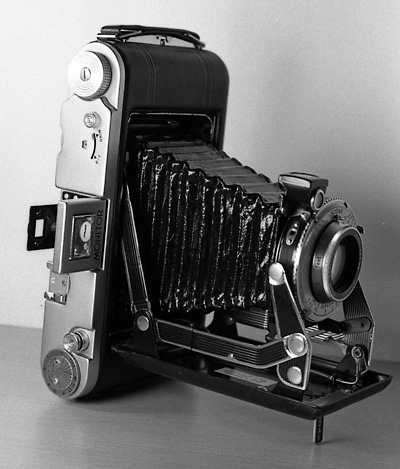 |
|
|
|
I originally got the idea to use 120 film in my Kodak Monitor Six-16 from an article on Robert Monaghan's website about using old 1A (616 film) and 3A (122 film) cameras to make 6x12cm and 6x14cm panoramics.
The cameras are cheap (~$20 on eBay), and the process is pretty easy. Some of the cameras like the Kodak Vigilant Jr. or the Kodak 1A Pocket cameras have very limited shutter speeds, and I'm assuming the lenses are nothing to write home about, so something like the Kodak Monitor is a good choice. It has an 127mm Anastigmat Special f4.5 lens (a tessar formula), which I believe was also sold as an Ektar for large format cameras. There is also a version of this lens that is f6.3, but it is a three element design. Shutter speeds are B and 1-1/400 seconds. It uses front focusing by distance (aka guesstimation). There is a pop-up viewfinder with manual parallax correction as well as a waist level finder. |
|
|
|
Using 120 Film:
Here's How I Did It... |
|
|
|
 |
|
|
The main difficulty of using 120 film in a 616 camera is that the 120 spool is about 1/2 an inch shorter than a 616 spool. |
|
|
|
|
|
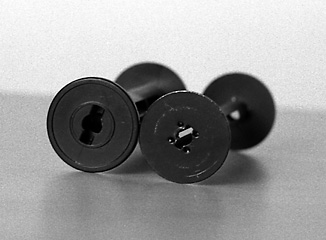 |
|
|
|
|
|
|
The end of the 120 spool is also just slightly larger than the 616 spool. Also, the hole is a little larger, so the winding "key" thing that fits into the take-up spool may or may not fit as snugly as it needs to. This varies a little by the brand of film. |
|
|
|
|
|
In order to convert the 120 spool to fit into the camera, I used some adapters that I found on eBay. They could be made very easily -- they are basically just a plastic washer that is approximately the thickness of a U.S. quarter (25cent piece) with a thin metal piece glued on top with a hole cut in it the appropriate size for the winding key. |
|
|
|
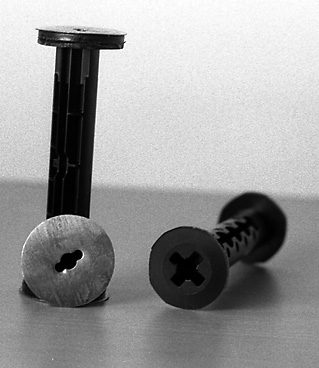 |
|
|
|
I found that I also needed to trim the edges of the 120 spool so that they would fit into the camera. I glued the adapter onto the top of a spool and then clipped around the edges of the 120 spool that were left sticking out with a pair of nail clippers. |
|
|
|
|
|
 |
|
|
Here is the take-up spool with an adapter glued to the top and bottom and a quarter stuck in the bottom to fill in a little bit of extra space. Since this I have decided it is better to glue only one of the adapters on the top (because you really do need the smaller hole so that the winding key fits snugly), and then I use two quarters to fill in the space at the bottom instead of two.
On the supply spool side, I don't modify the 120 spool at all. It is a very tight fit, so you may be tempted to try trimming around the edges of the spool w/ nail clippers, but, at least in this camera, it's really not necessary. In any case, I jam the 120 spool into the supply side and put two quarters on either side of it. Quarters are your friend. |
|
|
|
|
|
|
As you can see below, this perfectly centers the roll of film in the camera. I found that the film had a slight tendency to curl, so in the interest of film flatness I place a strip of packing tape approximately 1.5cm down both the long edges of the frame with about 3 or 4mm sticking out. This gives something for the film to rest against, and you only sacrifice a little bit of your negative width (if not for this, you could get a full 6cm wide negative). |
|
|
|
|
|
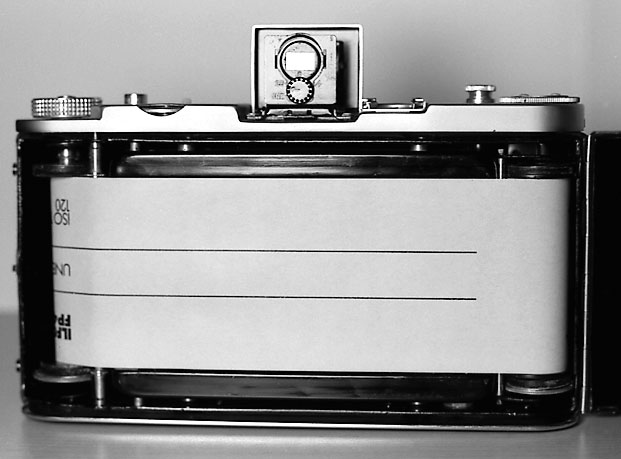 |
|
|
|
So, that's about it. All you have to do now is close the door and take some pictures. The red window is lined up with the 645 numbers on the paper backing, so I use numbers 3, 6, 9, 12 and 15. This leaves a lot of space (about 3cm) in between negatives and a lot of space at the end. I know I could easily fit 6 negatives to a roll, but I haven't bothered to figure out how to wind it without using the numbers as a reference.
[NOTE: I took the time to work out the following method of getting 6 frames on a roll of film. This works with Ilford films (FP4+ & XP2, at least, but I assume any Ilford) and Konica Infrared 750. I haven't had a chance to test it with Kodak films yet. Anyway, wind to the following numbers: 2+two "dots", 5, 7+two dots, 10, 12+two dots, and 15. If you're wondering what "dots" I'm talking about, just try it...you'll see. This requires you to pay a little bit more attention while winding, but I think it is worth it to get an extra frame.]
A couple more interesting tidbits about my camera specifically is that it still had the original owners name/address tag inside it. Also there is a sticker from Kodak noting that the camera was serviced in the 1950. So, if anyone knows Paul H. Everson, let him know I'm enjoying his camera. |
|
|
|
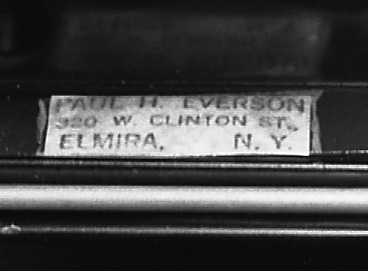 |
|
|
|
 |
|
|
|
Feel free to email me if you have any questions, etc. |
|
|
|
to the gallery |
|
|
|

|
|








